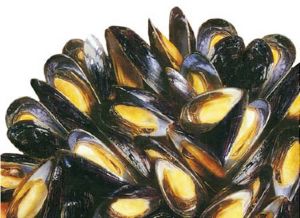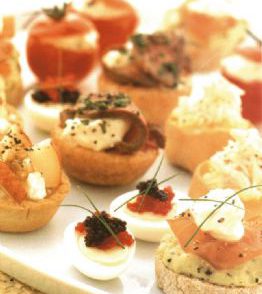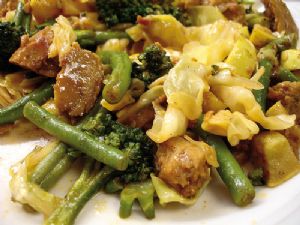There’s little doubt that readers in Tuscany with sweet tooths are spoiled from the moment they wake up in the morning until the time comes to brush their teeth at night. Dolci for breakfast, a morning snack, more paste at lunch, something sweet to taste in the evening and then a delicate dessert: each made with the freshest ingredients that the region’s orchards give up and assem-bled with the kind of care and attention that would make a pastry chef from any other country gnash his teeth and wring his tall, white hat between his flour-dusted hands. That’s not to say, however, that we can’t take influences from abroad and combine them with Italian techniques and—crucially—summer-fresh ingredients, to make something a little bit different.
Taking as our base the sorts of things that go into light, fresh desserts from the region, we find international parallels that work perfectly with Tuscan ingredients. Let’s consider the kinds of flavours and textures that work well to cap off an amazing summer supper—preferably enjoyed outdoors, on an architecturally lovely parapet, with something very nice to drink, a hot date and a collection of hitherto undiscovered Beastie Boys remixes on the stereo (obviously, this depends upon you really, really liking the Beastie Boys, but just indulge me here).
Light whipped cream, mascarpone or ricotta bases for either cold desserts or baked puddings; citrus- or vanilla-flavoured creams and custards; batters enveloping fresh fruit and berries; pieces of meringue, puff pastry; delicately bitter chocolate and coffee flavours; tart green fruits; robustly flavoured berries with warm, alcoholic notes, crisp slices of ultra-fresh orchard fruits; and frozen dairy: these carry an overwhelming sense of ‘summer’s here’ even more stridently than the whiff of SPF 25 and the sensation of sand in your Converse.
The traditional Tuscan pudding of mascarpone, lemon and sugar, in its unbaked form, finds an international cousin in the ridiculously named but extremely well-aged syllabub: a British dessert of whipped cream, brandy, lemon and sugar that probably originated in the court of Queen Elizabeth I and provides just enough flavour to satisfy the sweet part of your tongue without making you feel as if you’re about to burst (let’s not forget, they used to eat entire swans at dinner in those days, so lightness was a key dessert requirement). Alternatively, the similarly ridiculously named fool can be made with finely strained fruit puree and whipped cream (and, some say, beaten egg whites): serve them in chilled layers or mixed together. Rhubarb puree makes a fantastic fruity addition to a fool; you’ll find a recipe elsewhere on this page.
Granita is an essential dessert for summer, but blend in tiny pieces of meringue and you have a really old-school sorbet. Try making this with something other than fruit puree, like a mixture that has been infused with citrus juices and some sweetened Earl Grey tea. And if you have meringue left over, you can make yourself a pavlova-esque dish by layering the pieces with cream or softened ice cream and fresh fruits (traditionally raspberries, but sliced strawberries soaked in sugar syrup for an hour or two are also great). Or you can again take a cue from another ridiculously named English dessert, the Eton Mess. Served at the super-exclusive school of the same name, it’s simply the result of smashing together all of the constituent bits of a pavlova—presumably with something very heavy, like a big bag of money or a bust of Cicero—and serving them mixed up in a bowl. I’d suggest trying different fruits with this: it’s great with a mix of frutti di bosco (wild berries).
Puff pastry with a little sugary almond paste, topped with slices of fresh apple and a sugar and gelatine glaze and then baked, makes a great cold dessert (serve with vanilla ice cream). You can also try folding pieces of cherry and some dark chocolate syrup into softened vanilla ice cream for summery Italian take on the flavours of a German schwarzwalderkirschtorte. And while we’re thinking of cherries, you can place them in the bottom of small ramekin dishes with a pancake batter made from flour, salt, sugar, egg and milk; bake until the batter rises to form individual (and delicious) cherry cakes known as clafoutis in the Limousin region of France.
The simplest pudding of all, though, has to be one of the most satisfying: soak a whole load of frutti di bosco (seeds and pips removed) in sugar syrup until the entire lot has softened and gone dark purple-red and juicy. Line a glass bowl with slices of crustless sandwich bread, fill with the fruit, top and seal with more bread and weigh down with a plate and a couple of tins: chill until it can be turned out onto a plate, whole—a delicious, sweet, brightly coloured summer pudding, to serve in slices with sour cream or thick, sweet yoghurt. It’ll fall apart on your friends’ forks and stain their lips with sweet syrup. But believe me, they won’t care.
RECIPES
Recipe of the fortnight: RHUBARB FOOL
400g rhubarb (found at specialty markets in town)
60g fine sugar
1 glass orange juice
200 ml cream
1 egg white
Boil the rhubarb in a saucepan (one that won’t mark or corrode from the acid in the fruit) with the sugar and orange juice, and enough water to cover, until soft and falling apart (15 minutes or so).
Strain the fruit and then puree. Pass the puree through a strainer to remove any small pieces of fruit fibre. Allow to cool, and then chill in the fridge.
Beat the egg white until it forms stiff peaks; you should be able to turn the bowl upside down without the white looking like it’s about to fall out. Do the same with the cream. Mix the two together.
Layer fruit and cream mix in four large Martini glasses. Chill in the fridge until ready to serve.







